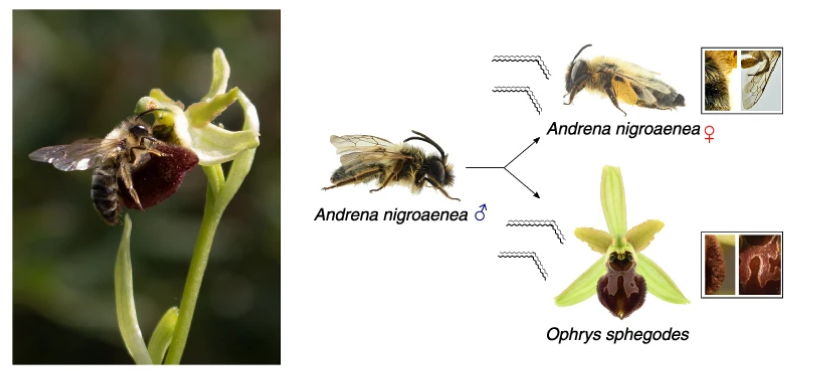The Spider Orchid That Attracts Male Bees
The spider orchid (Ophrys sphegodes) is a species of the orchid genus native to Europe and the Middle East. It possesses distinctive petals that mimic bees and is a highly intriguing plant that enhances its pollination rate by attracting male bees.
Not only do the petals of the spider orchid resemble female bees, but there are also various strategies hidden within to attract male bees. For instance, the spider orchid produces substances similar to the pheromones released by female bees, which guide male bees towards it. In addition to the scent, the color of the petals, which mimics the body color of the target male bees, is also an important feature for attracting them.
While the spider orchid maintains the traits necessary for attracting male bees, the fragrance components and ultraviolet reflection patterns that are not essential for attraction are rich in diversity. It is said that this diversity prevents male bees from remembering the flowers and not returning to them.
While retaining the functions necessary for attracting male bees, the genetic evolution that has resulted in the diverse flowers of the spider orchid is being investigated.

Gene Transfer Created the Diversity of the Spider Orchid
The function of attracting male bees in the spider orchid is very complex. By mimicking female bees and being diverse as a flower, it becomes an attractive entity to male bees. This was achieved as a result of evolution over tens of thousands of years.
Analysis of the spider orchid’s genes revealed that “transposons” are involved in the genes related to fragrance components and flower shape. Transposons are specific gene sequences that can be inserted into genes or move to other locations. When inserted into a specific gene, they can alter or, in some cases, deactivate the gene’s function. On the other hand, when the transposon leaves the gene, the gene’s function may be restored, leading to changes in scent or flower shape.
Transposons exist abundantly in genes and repeatedly replicate and move, changing the plant’s traits at the genetic level. It is like “adding” to a blueprint or having parts that were already written suddenly removed, resulting in a product that is intricately altered.
In the case of the spider orchid, its blueprint has been added to and deleted over millions of years, transforming it into a complex genus with diverse traits.
Genetic Changes Over Millions of Years: Evidence of Gene Increase During the Ice Age
By examining the genetic differences in closely related species, it is possible to infer what genetic changes have occurred within that group. In the case of the spider orchid, genetic comparisons reveal millions of years of evolution. For example, it is believed that the spider orchid 4.9 million years ago was pollinated by wasps and later transitioned to being pollinated by bees. Then, within the last one million years, the genes of the spider orchid rapidly diversified, leading to an increase in species. During this time, Europe and the Middle East experienced the ice age and interglacial periods, known for harsh climate conditions. To adapt to these climate changes, the spider orchid rapidly increased its genetic diversity. It is hypothesized that this genetic increase led to the emergence of diversity, and further mutations caused by transposons resulted in an extremely complex species composition.
Hidden Potential for Breeding in the Spider Orchid
The genetic changes that took millions of years in the natural world can now be inferred. The diversity of the spider orchid is the result of the complex interplay between gene increase and transposon-induced mutations. Transposon-induced genetic changes occur in various plants, not just the spider orchid. In past breeding, single-gene mutations were the primary focus, and this technique has produced many useful varieties. However, looking at the example of the spider orchid, it seems possible to create even more diverse varieties by applying the complex gene interactions.
The dimension of breeding may rise even further in the future. Although it is difficult to predict the combinations of diverse genes, the day when breeding that involves creating new varieties using machine learning and AI becomes mainstream may not be far off.



コメント